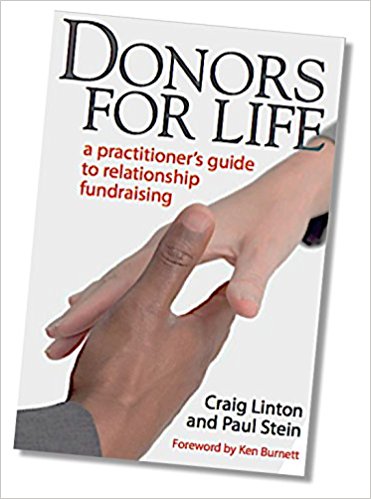A conversation heard ‘round the fundraising world happened within the last few months. A fundraising leader ignited the talk by publishing an article on his blog. His post focused on the idea that donor-centricity is problematic, and that fundraisers ought to instead look toward community-based fundraising solutions. Almost immediately, I noticed a huge problem: the definition of donor-centricity was not only incredibly vague but negatively skewed and stereotyped.
It didn’t match my fundraising experiences at all, nor did it match the experiences of many of my colleagues.
 So here’s the thing: my experiences have taught me that donor-centricity works best when it’s executed in the right way. Donor-centricity itself has never been the problem. Its execution, on the other hand, is a persistent problem. Donors for Life: a practitioner’s guide to relationship fundraising, is a valuable tool that can empower fundraisers to execute donor-centricity effectively.
So here’s the thing: my experiences have taught me that donor-centricity works best when it’s executed in the right way. Donor-centricity itself has never been the problem. Its execution, on the other hand, is a persistent problem. Donors for Life: a practitioner’s guide to relationship fundraising, is a valuable tool that can empower fundraisers to execute donor-centricity effectively.
Craig and Paul’s experiences have apparently revealed similar truths. Their new book is organized into four sections across twenty chapters, making the content easily accessible and digestible. They work from the bottom up, from building a solid foundation that explores its principles, relevance, and strategy and ending with how to learn from your donors as a part of the relationship-building process.
What emerges is a comprehensive roadmap that can empower nonprofits to reach their fundraising potential. You’ll find a step-by-step plan that’s not only all-inclusive (community fundraising is part of the big picture), but is backed with the latest research, case studies, and examples. A plan that provides plenty of room for navigation, whether this is new territory or you’ve been here before, but you’ve got some work to do.
Every chapter is both intentional and useful, but I’ve found myself returning to chapters 7, 8, and 9 often.
Chapter 7: Recruiting your donors outlines a system for producing an effective direct marketing program that compels donors to not only give now but give for the long haul. The Boston Matrix is a useful metric for assessing and streamlining the puzzle that is your overall fundraising plan.
Chapter 8: The seven elements of successful donor recruitment outlines a plan with the power to compel your donors to respond, beginning with selecting the proper media channel, and ending with tailoring the response mechanism. At its core lies the idea that effective emotional storytelling is a critical tool in effective communications.
Chapter 9: The seven elements in action: four outstanding recruitment campaigns includes examples that are both effective and familiar to me (I’ve highlighted both OXFAM and Soi Dog multiple times for their glowing communication pieces). The selections here are nothing short of inspiring.
This is an important book for any fundraiser, regardless where they at this moment in time. What exists here is the ideal balance of timelessness and 2017, and it’s all woven together into something intentional, cohesive, and powerful. I highly recommend Donors for Life to any fundraiser who wants to make money but knows that successful fundraising depends on their donors. And if you aren’t there yet, *now* is the time.

















 I can’t wait to meet with you personally.
I can’t wait to meet with you personally.
Comments on this entry are closed.